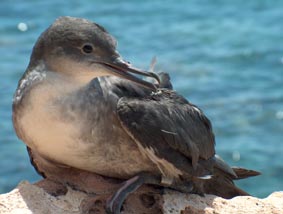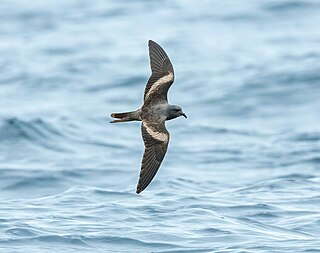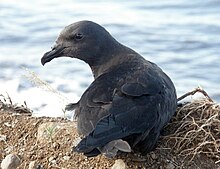
Procellariiformes is an order of seabirds that comprises four families: the albatrosses, the petrels and shearwaters, and two families of storm petrels. Formerly called Tubinares and still called tubenoses in English, procellariiforms are often referred to collectively as the petrels, a term that has been applied to all members of the order, or more commonly all the families except the albatrosses. They are almost exclusively pelagic, and have a cosmopolitan distribution across the world's oceans, with the highest diversity being around New Zealand.

The family Procellariidae is a group of seabirds that comprises the fulmarine petrels, the gadfly petrels, the diving petrels, the prions, and the shearwaters. This family is part of the bird order Procellariiformes, which also includes the albatrosses and the storm petrels.

The Balearic shearwater is a medium-sized shearwater in the seabird family Procellariidae. Puffinus is a Neo-Latin loanword based on the English "puffin" and its variants, that referred to the cured carcass of the fat nestling of the Manx shearwater, a former delicacy. The specific mauretanicus refers to Mauretania, an old name for an area of North Africa roughly corresponding to Morocco and Algeria. The Balearic Shearwater is listed critically endangered by the IUCN and is one of Europe's most endangered seabirds.

The black-capped petrel, also known as the diablotín, is a small seabird native to the West Indies in the genus Pterodroma. It is a long-winged petrel with a grey-brown back and wings, with a white nape and rump. Underparts are mainly white apart from a black cap and some dark underwing markings. It picks food items such as squid from the ocean surface.

The magenta petrel, or Chatham Island tāiko, is a small seabird in the gadfly petrel genus, Pterodroma. Found exclusively on Chatham Island, New Zealand, it is one of the rarest birds in the world, believed to be extinct for over 100 years before its rediscovery in the 1970s.

The providence petrel is a large and heavy build gadfly petrel that nests in two locations in the Tasman Sea: Lord Howe Island and Philip Island.

The Galápagos petrel is one of the six endemic seabirds of the Galápagos. Its scientific name derives from Ancient Greek: Pterodroma originates from pteron and dromos, meaning "wing" and "runner", and phaeopygia comes from phaios and pugios, meaning "dusky" and "rump". Members of Pterodroma genus are also called the gadfly petrels because their erratic twisting and turning in flight resemble that of gadflies.
The Fiji petrel, also known as MacGillivray's petrel, is a small, dark gadfly petrel.

Barau's petrel is a medium-sized gadfly petrel from the family Procellariidae. Its main breeding site is the island of Réunion in the Indian Ocean.
Beck's petrel is a small species of petrel. Its specific epithet commemorates American ornithologist Rollo Beck. It is believed to nest on small islands with tall mountains around Melanesia. Described in 1928, and long known from only two specimens, sightings and collections in the 2000s confirmed the birds still existed, but are considered critically endangered by the IUCN.

Cook's petrel, or the tītī or blue-footed petrel, is a Procellariform seabird. It is a member of the gadfly petrels and part of the subgenus Cookilaria Bonaparte, 1856, which includes the very similar Stejneger's petrel.

The Bonin petrel or nunulu is a seabird in the family Procellariidae. It is a small gadfly petrel that is found in the northwest Pacific Ocean. Its secretive habits, remote breeding colonies and limited range have resulted in few studies and many aspects of the species' biology are poorly known.

Pseudobulweria is a genus of seabirds in the family Procellariidae. They have long been retained with the gadfly petrel genus Pterodroma despite morphological differences. Mitochondrial DNA cytochrome b sequence analysis has confirmed the split out of Pterodroma and places the genus closer to shearwaters. They thus represent either a plesiomorphic lineage still sharing some traits of the ancestral Procellariidae with the gadfly petrels, or convergent evolution of a shearwater to the ecological niche of gadfly petrels.

The white-bellied storm petrel is a species of seabird in the family Oceanitidae. It is found in Angola, Argentina, Australia, Brazil, Chile, Ecuador, French Polynesia, French Southern Territories, Maldives, Namibia, New Zealand, Perú, Saint Helena, and South Africa. Its natural habitat is open seas.

The Polynesian storm petrel is a species of seabird in the family Oceanitidae. It is the only species placed in the genus Nesofregetta. This species is markedly polymorphic, consisting of several subspecies. At one time the light-colored variety were even considered a species on their own. However, subspecies are not generally accepted today.

Elliot's storm petrel is a species of seabird in the storm petrel family Oceanitidae. The species is also known as the white-vented storm petrel. There are two subspecies, O. g. gracilis, which is found in the Humboldt Current off Peru and Chile, and O. g. galapagoensis, which is found in the waters around the Galápagos Islands. It is a sooty-black storm petrel with a white rump and a white band crossing the lower belly and extending up the midline of the belly. It has long legs which extend beyond the body in flight.

Markham's storm petrel is a seabird native to the Pacific Ocean around Peru, Chile, and Ecuador. The species is named after British explorer Albert Hastings Markham, who collected the specimen on which the scientific description was based. It is a large and slender storm petrel, with a wingspan between 49 and 54 cm. Its plumage is black to sooty brown with a grayish bar that runs diagonally across the upper side of the wings. A member of the family Hydrobatidae, the northern storm petrels, the species is similar to the black storm petrel, from which it can be hard to distinguish.

The Tahiti petrel is a medium-sized, dark brown and white seabird found across the Pacific Ocean. The species comprises two subspecies: P. r. rostrata which breeds in the west-central Pacific Ocean, and P. r. trouessarti which breeds in the tropical and subtropical Pacific Ocean. The Tahiti petrel belongs to the Procellariidae family and is the most studied member of the Pseudobulweria genus which comprises three critically endangered species. Similarly, the Tahiti petrel is considered near threatened by the 2018 IUCN Red List of Threatened Species. Threats include introduced rats, feral cats, pigs, dogs, nickel mining, and light pollution.

Pycroft's petrel is a species of seabird in the petrel and shearwater family Procellariidae.

The Herald petrel is a species of seabird and a member of the gadfly petrels. Its range includes the south Pacific Ocean and Indian Ocean.


















